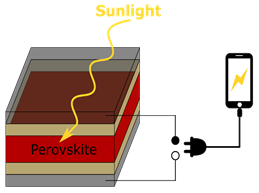

27th July 2023 (7 Topics)
Context
Recently, scientist has developed a new technology named ‘RoboMapper’ which have been able to develop alloys with ‘perovskites materials’ that can improve solar cells.
About the Technology:
- The RoboMapper is able to develop alloys with perovskites materials that can do material testing in a more efficient and sustainable manner.
|
Alloys: Is metallic substance composed of two or more elements, as either a compound or a solution. |
- It also automates the process of material testing, by placing dozens of samples on each chip by miniaturizing the material samples with the help of modern printing.
What are Perovskites?
- Perovskite is a naturally occurring mineral of calcium titanate with a chemical formula of CaTiO3.
- This mineral was first discovered by German mineralogist Gustav Rose in 1839.

Why is it significant of solar energy extraction?
- All photovoltaic solar cells rely on semiconductors — materials in the middle ground between electrical insulators such as glass and metallic conductors such as copper — to turn the energy from light into electricity.
- Light from the sun excites electrons in the semiconductor material, which flow into conducting electrodes and produce electric current
- Perovskites is desirable because it can absorb sunlight better than silicon, which means the cells can be lighter.
- Silicon has been the primary semiconductor material used in solar cells since the 1950s, as its semiconducting properties align well with the spectrum of the sun’s rays and it is relatively abundant and stable.
- However, the large silicon crystals used in conventional solar panels require an expensive, multi-step manufacturing process that utilizes a lot of energy.
How it can be processed into cells?
- Perovskite solar cells can be manufactured using simple, additive deposition techniques, like printing, for a fraction of the cost and energy.
- Because of the compositional flexibility of perovskites, they can also be tuned to ideally match the sun’s spectrum.
- In 2012, researchers first discovered how to make a stable, thin-film perovskite solar cell with light photon-to-electron conversion efficiencies over 10%, using lead halide perovskites as the light-absorbing layer.
- Since then, the sunlight-to-electrical-power conversion efficiency of perovskite solar cells has skyrocketed, with the laboratory record standing at 25.2%.
More Articles


